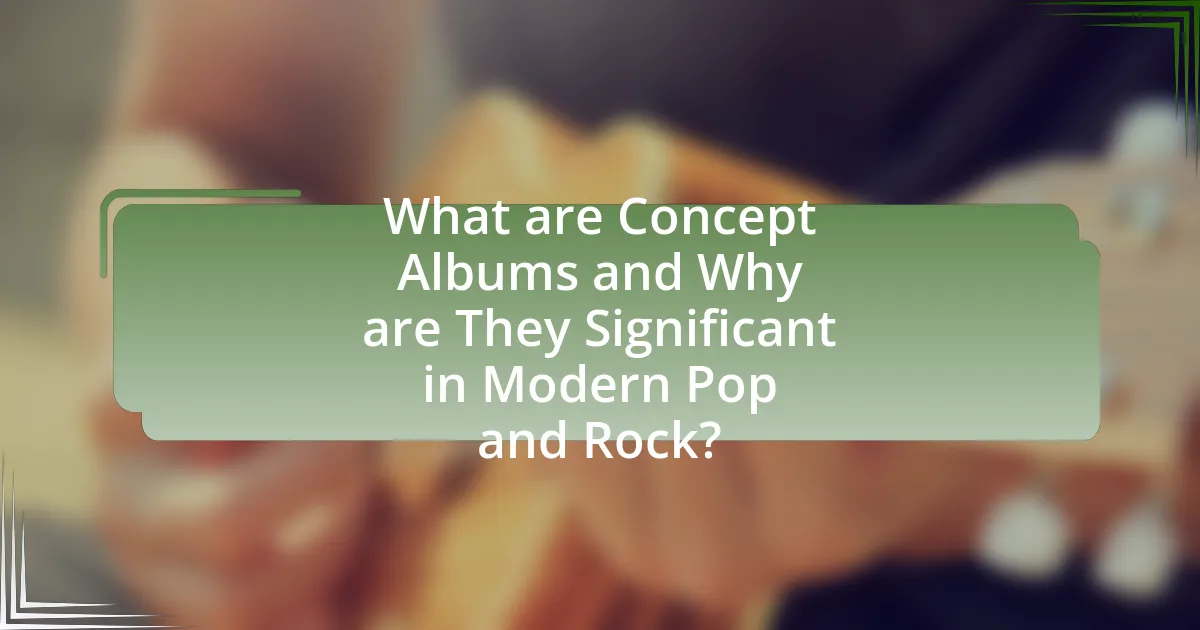Concept albums are musical works unified by a central theme or narrative, significant in modern pop and rock for their ability to create immersive listening experiences. This article analyzes the characteristics that distinguish concept albums from traditional albums, including their narrative structure, thematic coherence, and the emotional depth they provide. It explores the resurgence of concept albums in recent years, driven by cultural shifts and the influence of streaming platforms, while also examining the impact of these albums on artists and audiences. Key themes, personal experiences, and social issues addressed in concept albums are discussed, along with best practices for creating them and strategies for enhancing listener engagement.

What are Concept Albums and Why are They Significant in Modern Pop and Rock?
Concept albums are musical works that are unified by a central theme or narrative, often exploring complex ideas or storytelling throughout the tracks. Their significance in modern pop and rock lies in their ability to create immersive listening experiences, allowing artists to express deeper artistic visions and engage audiences on multiple levels. For instance, Pink Floyd’s “The Wall” and Kendrick Lamar’s “To Pimp a Butterfly” exemplify how concept albums can address social issues and personal struggles, enhancing the emotional impact of the music. This format encourages listeners to experience the album as a cohesive whole rather than just a collection of singles, fostering a stronger connection between the artist and the audience.
How do Concept Albums differ from Traditional Albums?
Concept albums differ from traditional albums primarily in their narrative structure and thematic coherence. While traditional albums typically consist of a collection of standalone songs, concept albums are designed around a central theme or story that connects the tracks, creating a cohesive listening experience. For example, Pink Floyd’s “The Wall” serves as a narrative exploration of isolation and personal struggle, illustrating how the songs interrelate to convey a unified message. This structural approach enhances the emotional depth and artistic expression of the music, distinguishing concept albums in the landscape of modern pop and rock.
What elements define a Concept Album?
A concept album is defined by its cohesive narrative or thematic structure that connects all the songs within it. This narrative can be a story, a character arc, or an overarching theme that provides a unified listening experience. Additionally, concept albums often feature recurring musical motifs, lyrical references, and stylistic elements that reinforce the central theme, creating a sense of continuity throughout the album. Historical examples, such as Pink Floyd’s “The Wall” and The Who’s “Tommy,” illustrate how these elements work together to engage listeners on multiple levels, making the album more than just a collection of individual tracks.
How do narratives shape the listening experience of Concept Albums?
Narratives significantly shape the listening experience of concept albums by providing a cohesive storyline that guides the audience through the music. This structured approach allows listeners to engage more deeply with the themes and emotions presented, enhancing their overall connection to the work. For instance, Pink Floyd’s “The Wall” uses a narrative arc to explore complex themes of isolation and mental health, which invites listeners to interpret the music in the context of the story, thereby enriching their emotional response. Additionally, the integration of narrative elements can create a sense of continuity and progression, making the listening experience feel more immersive and intentional. This narrative-driven format has been shown to increase listener investment, as evidenced by the critical acclaim and commercial success of albums like “American Idiot” by Green Day, which tells a compelling story that resonates with audiences.
Why have Concept Albums gained popularity in recent years?
Concept albums have gained popularity in recent years due to their ability to provide a cohesive narrative experience that resonates with listeners. This trend is supported by the rise of streaming platforms, which allow artists to present their work as a complete story rather than individual tracks. Additionally, the increasing consumer demand for immersive and thematic content in music has led to a resurgence in the creation of concept albums. For instance, albums like “To Pimp a Butterfly” by Kendrick Lamar and “The Rise and Fall of Ziggy Stardust and the Spiders from Mars” by David Bowie showcase how storytelling can enhance emotional engagement and listener investment. This shift reflects a broader cultural movement towards valuing artistic expression that transcends traditional song formats.
What cultural factors contribute to the resurgence of Concept Albums?
The resurgence of concept albums is primarily driven by the cultural shift towards storytelling and thematic coherence in music. This trend reflects a growing audience preference for immersive experiences, as evidenced by the success of artists like Kendrick Lamar and Taylor Swift, who have released albums with interconnected narratives. Additionally, the rise of streaming platforms has facilitated the consumption of entire albums rather than individual tracks, encouraging artists to create cohesive works. The cultural emphasis on artistic expression and the desire for deeper emotional connections in music further support this resurgence, as listeners seek albums that resonate on multiple levels.
How do streaming platforms influence the popularity of Concept Albums?
Streaming platforms significantly enhance the popularity of concept albums by providing easy access and promoting curated playlists that feature these albums. The algorithms used by platforms like Spotify and Apple Music often highlight concept albums, especially when they align with user preferences, leading to increased visibility and listener engagement. For instance, Spotify’s “Discover Weekly” and “Release Radar” playlists frequently include new concept albums, which can result in a surge of streams and downloads shortly after release. This accessibility allows artists to reach wider audiences, as evidenced by the rise of concept albums from artists like Kendrick Lamar and Pink Floyd, whose works have gained renewed attention through streaming services.

What are the Key Characteristics of Successful Concept Albums?
Successful concept albums are characterized by a cohesive narrative or theme that runs throughout the entire work. This narrative structure allows for a deeper emotional connection and engagement from listeners, as seen in albums like Pink Floyd’s “The Wall,” which explores themes of isolation and mental health. Additionally, successful concept albums often feature interconnected songs that transition smoothly from one to another, enhancing the storytelling experience. For instance, The Who’s “Tommy” presents a continuous musical journey that maintains listener interest. Furthermore, strong lyrical content that reflects the overarching theme is crucial; for example, David Bowie’s “The Rise and Fall of Ziggy Stardust and the Spiders from Mars” uses vivid storytelling to convey its narrative. Lastly, innovative production techniques and instrumentation can elevate the concept, as demonstrated by Radiohead’s “OK Computer,” which integrates electronic elements to complement its themes of alienation and technology.
What themes are commonly explored in Modern Concept Albums?
Modern concept albums commonly explore themes such as identity, personal struggle, societal issues, and existentialism. These themes are often interwoven to create a cohesive narrative throughout the album, allowing artists to delve into complex emotional landscapes. For instance, albums like “To Pimp a Butterfly” by Kendrick Lamar address racial identity and systemic oppression, while “The Wall” by Pink Floyd examines isolation and mental health. Such thematic depth not only enhances the listening experience but also invites critical engagement from audiences, reflecting broader cultural conversations.
How do artists use personal experiences in their Concept Albums?
Artists use personal experiences in their concept albums to create relatable narratives that resonate with listeners. By drawing from their own life events, emotions, and struggles, musicians can craft cohesive stories that enhance the thematic depth of their work. For instance, Pink Floyd’s “The Wall” explores themes of isolation and trauma, reflecting the band’s experiences and societal observations. Similarly, Kendrick Lamar’s “good kid, m.A.A.d city” narrates his upbringing in Compton, providing a vivid portrayal of his personal journey. These albums often incorporate autobiographical elements, allowing artists to connect with audiences on a deeper emotional level, thereby increasing the albums’ impact and popularity.
What social issues are often addressed in these albums?
Concept albums in modern pop and rock often address social issues such as mental health, inequality, and systemic injustice. For instance, albums like “To Pimp a Butterfly” by Kendrick Lamar tackle racial inequality and the struggles of the African American community, while “American Idiot” by Green Day critiques American politics and consumerism. These albums use storytelling and thematic cohesion to highlight pressing societal concerns, making them relevant and impactful in contemporary discourse.
How do musical styles and production techniques enhance Concept Albums?
Musical styles and production techniques enhance concept albums by creating a cohesive narrative and immersive listening experience. Diverse musical styles, such as progressive rock or orchestral arrangements, allow artists to express complex themes and emotions, while production techniques like layering, sound design, and thematic motifs help to unify the album’s concept. For instance, Pink Floyd’s “The Wall” employs varied musical styles and innovative production to convey its story of isolation and alienation, demonstrating how these elements can deepen the listener’s engagement with the narrative.
What role does instrumentation play in conveying the album’s narrative?
Instrumentation plays a crucial role in conveying an album’s narrative by enhancing emotional depth and thematic coherence. Specific instruments and their arrangements can evoke particular moods, reflecting the storyline or concepts presented in the lyrics. For instance, the use of strings may create a sense of nostalgia, while electronic elements can introduce a futuristic or surreal atmosphere. This intentional selection and manipulation of sounds help to immerse the listener in the narrative, making the experience more engaging and impactful. Albums like Pink Floyd’s “The Wall” exemplify this, where instrumentation directly supports the album’s themes of isolation and despair through haunting melodies and dynamic shifts.
How do collaborations with other artists impact the success of Concept Albums?
Collaborations with other artists significantly enhance the success of concept albums by broadening their appeal and introducing diverse musical styles. When artists collaborate, they combine their fan bases, which can lead to increased visibility and sales. For instance, the collaboration between David Bowie and Brian Eno on the “Berlin Trilogy” resulted in innovative soundscapes that attracted both artists’ followers, contributing to the albums’ critical and commercial success. Additionally, collaborations often bring fresh perspectives and creative ideas, enriching the narrative and thematic depth of concept albums, as seen in the joint efforts of Kendrick Lamar and SZA on “Black Panther: The Album,” which received widespread acclaim and commercial success.

What Impact do Concept Albums Have on Artists and Audiences?
Concept albums significantly enhance the artistic expression of musicians while deepening the emotional connection with audiences. For artists, these albums allow for a cohesive narrative or theme, enabling them to explore complex ideas and showcase their creativity in a structured format. This approach can lead to critical acclaim and a stronger artistic identity, as seen with albums like Pink Floyd’s “The Wall,” which received widespread recognition for its storytelling and thematic depth.
For audiences, concept albums provide an immersive listening experience that encourages engagement beyond individual tracks. Fans often appreciate the journey that a concept album offers, as it invites them to interpret the overarching narrative. This engagement can foster a loyal fan base, as demonstrated by the success of albums like Kendrick Lamar’s “good kid, m.A.A.d city,” which resonated deeply with listeners due to its autobiographical storytelling and social commentary. Overall, concept albums serve as a powerful tool for both artists and audiences, enriching the music experience and fostering a deeper connection.
How do Concept Albums affect an artist’s career trajectory?
Concept albums significantly influence an artist’s career trajectory by enhancing their artistic credibility and expanding their audience reach. When artists create concept albums, they often showcase their storytelling abilities and thematic depth, which can lead to critical acclaim and increased media attention. For instance, Pink Floyd’s “The Wall” not only solidified their status as innovative musicians but also attracted a diverse fan base, contributing to sustained commercial success. Additionally, concept albums can lead to unique marketing opportunities, such as tours and merchandise that align with the album’s narrative, further solidifying an artist’s brand and increasing revenue streams.
What are the risks and rewards of creating a Concept Album?
Creating a concept album involves both significant risks and substantial rewards. The risks include potential alienation of mainstream audiences due to complex narratives or experimental sounds, which can lead to lower commercial success; for instance, albums like “The Wall” by Pink Floyd faced initial mixed reviews despite later acclaim. Conversely, the rewards consist of artistic expression and the ability to create a cohesive narrative that can resonate deeply with listeners, as seen with Kendrick Lamar’s “To Pimp a Butterfly,” which received critical acclaim and commercial success, highlighting the potential for a concept album to elevate an artist’s career and foster a dedicated fanbase.
How can Concept Albums redefine an artist’s image?
Concept albums can redefine an artist’s image by presenting a cohesive narrative or theme that showcases their artistic depth and creativity. This format allows artists to explore complex ideas and emotions, differentiating them from conventional albums that may focus on standalone tracks. For instance, Pink Floyd’s “The Wall” not only solidified their status as innovative musicians but also transformed public perception by addressing themes of isolation and societal critique, thus elevating their artistic identity. By engaging listeners in a more immersive experience, concept albums can shift an artist’s image from mere entertainers to profound storytellers, enhancing their cultural relevance and appeal.
What is the audience’s response to Concept Albums?
The audience generally responds positively to concept albums, appreciating their narrative coherence and artistic ambition. Fans often engage deeply with the thematic elements and storytelling aspects, which can enhance their overall listening experience. For instance, albums like Pink Floyd’s “The Wall” and Kendrick Lamar’s “good kid, m.A.A.d city” have received critical acclaim and commercial success, indicating that listeners value the immersive experiences these albums provide. Additionally, surveys and music reviews frequently highlight that audiences enjoy the complexity and depth that concept albums offer compared to traditional song collections.
How do listeners engage with the narrative of a Concept Album?
Listeners engage with the narrative of a Concept Album by immersing themselves in the thematic and storytelling elements presented throughout the tracks. This engagement often involves active listening, where listeners pay close attention to lyrics, musical transitions, and the overall flow of the album, allowing them to connect emotionally with the characters and themes. Research indicates that Concept Albums, such as Pink Floyd’s “The Wall” or The Who’s “Tommy,” create a cohesive story that encourages listeners to interpret and reflect on the narrative, enhancing their overall experience. This narrative-driven approach fosters a deeper connection, as evidenced by the popularity of albums that successfully integrate storytelling with music, leading to increased listener investment and discussion within fan communities.
What role does fan interpretation play in the success of Concept Albums?
Fan interpretation significantly enhances the success of concept albums by fostering deeper emotional connections and engagement with the music. When fans actively interpret the themes, narratives, and artistic choices within a concept album, they create a shared experience that amplifies the album’s impact. This engagement can lead to increased discussions, fan theories, and community building around the album, which in turn drives its popularity. For instance, albums like Pink Floyd’s “The Wall” and The Who’s “Tommy” have thrived partly due to fans dissecting their complex narratives, resulting in lasting cultural relevance and commercial success. This phenomenon illustrates that fan interpretation not only enriches the listening experience but also contributes to the longevity and acclaim of concept albums in the music industry.
What are some Best Practices for Creating a Concept Album?
Best practices for creating a concept album include establishing a clear narrative or theme, ensuring cohesive musical elements, and integrating lyrical content that supports the overarching story. A well-defined narrative provides listeners with a journey, while cohesive musical elements, such as recurring motifs or harmonies, enhance the thematic experience. Additionally, lyrics should reflect and advance the narrative, creating a seamless connection between music and story. For instance, Pink Floyd’s “The Wall” exemplifies these practices by intertwining its narrative of isolation with musical motifs that recur throughout the album, reinforcing the emotional impact and coherence of the concept.
How can artists effectively develop a cohesive narrative?
Artists can effectively develop a cohesive narrative by establishing a clear theme and storyline that connects each piece within their work. This involves outlining the central message or concept before creating individual songs or pieces, ensuring that each element contributes to the overall narrative arc. For instance, concept albums like Pink Floyd’s “The Wall” illustrate how a unified theme can enhance the listener’s experience by weaving together lyrics, music, and visuals that reflect a singular journey or idea. By maintaining consistency in tone, character development, and lyrical motifs, artists can create a compelling narrative that resonates with audiences and reinforces the album’s overarching message.
What strategies can be employed to enhance listener engagement?
To enhance listener engagement, artists can employ strategies such as storytelling, interactive elements, and multimedia integration. Storytelling allows artists to create a narrative that resonates with listeners, making the music more relatable and memorable. For instance, concept albums like Pink Floyd’s “The Wall” effectively use a cohesive story to draw listeners in. Interactive elements, such as social media engagement or live Q&A sessions, foster a sense of community and connection between the artist and the audience. Additionally, integrating multimedia components, such as visuals or videos that complement the music, can enhance the overall experience, as seen in Beyoncé’s “Lemonade,” which combines music with powerful imagery to deepen emotional impact. These strategies collectively contribute to a more immersive and engaging listening experience.




